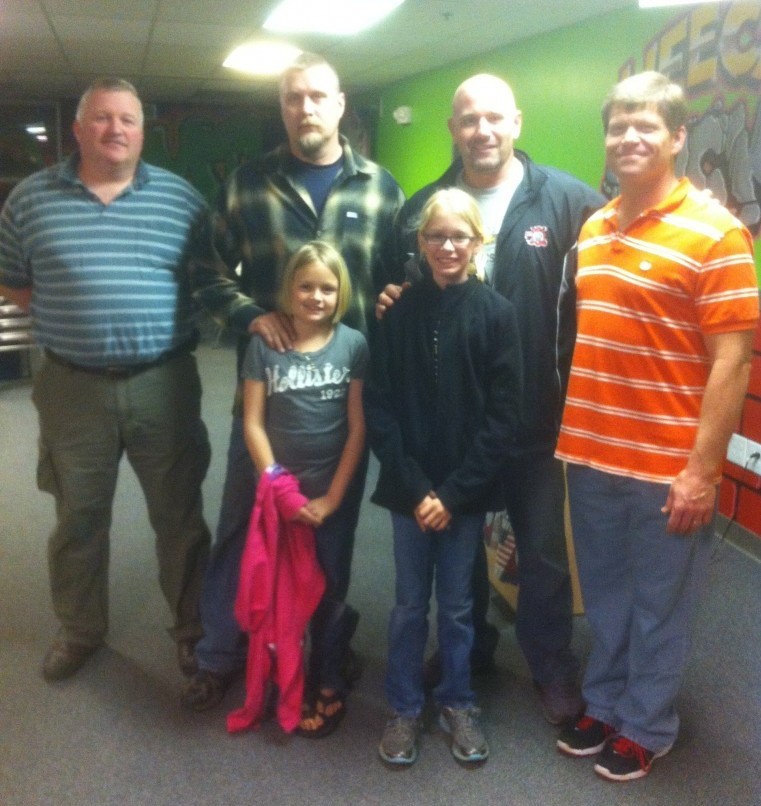
It had been a fairly ordinary day for Tammy Conover, who lives in Gorham. She went to work, ate her supper and headed to her church to take care of some children while their mothers attended a book club and their fathers a men’s group. The men were just across the hall. Clint Steele says suddenly the door opened and in walked two young girls.”I think the woman needs help,” one of them said.” She fell down and is not talking.”
Clint and three other men, including off-duty South Portland police officer Paul Lambert, rushed to the other room. Tammy was on the floor, eyes wide open, but not breathing. Her pulse was weak. Within seconds it was gone altogether. Her skin was turning blue.
Cardiac arrest.
Paul knew what had to be done — he is well-trained and had been called to do it before. He started mouth to mouth resuscitation. Clint had also received CPR training, but unlike Paul, it was the first time in his life he had to put it to use. He took a deep breath and started chest compressions. “It kind of came back to me,” he says, I don’t know that I was doing things perfectly but I just knew I had to start doing something.”
Throughout the whole experience Clint says he felt discouraged, but refused to quit. “Her eyes closed,” he describes, “and some tears went down the side of her face and I thought I was watching a woman die. I continued. I just thought I have to continue until someone gets here, so I did.”
Soon the room filled with Gorham police officers, firefighters and paramedics, who quickly took over the rescue effort. They used a special bag to force air into Tammy’s lungs and a defibrillator to deliver a jolt of electricity to her heart.
It took 19 1/2 minutes before they finally felt a pulse. “Even then things were not promising for the lady,” Paul says. “It was pretty serious.”
“Another 30 seconds and she would have been declared dead,” says Gorham police officer Ted Hatch.
Tammy was rushed to the hospital and put into a medically induced coma. If she lived, which seemed doubtful, she would probably have some brain damage. Clint says the doctor explained that, “Her brain went long periods with no oxygen, so not to expect much.”
Two days later, at around 4 am, Tammy woke up on her own — in a hospital bed, connected to life support. She had no memory of fainting or anything else up to the moment she came to. “I was just setting up chairs and went down,” she says. “I don’t remember feeling dizzy or falling.”
The doctors told her she’d had a heart attack, but it wasn’t caused by any blockages in her arteries. Instead, it appears that some unknown virus may have caused her to faint and triggered the heart attack. She now has a defibrillator, kind of like a pacemaker, implanted just under the skin beneath her shoulder — in case she ever faints again and her heart stops beating.
Paul, Clint and Officer Hatch had braced themselves for a worst-case scenario and were all shocked when they heard that Tammy was not only alive, but appeared to be just fine.
“I went to visit her at the hospital and I walked in and she was watching TV,” describes Clint. “I introduced myself and she said, ‘I don’t know what I’m doing here. I feel fine.”‘
“It was amazing,” says Hatch.
“A lot of things went her way that night,” Paul says, “and I think, I believe, there was some other help going on there.”
Was it a miracle?
Tammy certainly thinks so. “I could have been home alone,” she says. “I was driving just an hour before it happened. It happened in a church. Everyone there was praying, that’s for sure, and these people did CPR on me for 19 1/2 minutes. If I didn’t have that I would either be dead or have brain damage. Someone doing CPR on me kept the oxygen going. If it wasn’t for them I wouldn’t be here.”
A little over a year has passed since Tammy Conover’s life almost ended. The message we take from her experience is obvious.
Paul: “It’s so important to learn CPR. You just don’t know when you might be called to use it. It could be at your house, in the grocery store. It could be your children, your parents, anybody.”
Clint: “You never know when something like this is going to happen. Everyone needs to at least go through a class and be prepared.”
Tammy: “I’m just very thankful for where I was when it happened and that people cared enough to come and help me.”

First on the scene to help Tammy
Back L to R: Paul Lambert, Chuck Carman, Clint Steele, Tom Pequinot
Front L to R: Carli Carman, Brooke Carman
Source: Clint Steele
Hands-Only CPR
The Heart Association is encouraging everyone to learn how to do something called Hands-Only CPR. It consists of two simple steps.
- Call 911
- Push hard and fast in the center of the chest (To the beat of Stayin’ Alive by the Bee Gees.)
You can get more information and see some videos, including the one below, on the Hands-Only CPR website. And think of Tammy Conover if you wonder about having the time to watch a demonstration or take a class. She is only 49 years old. Thirty seconds more and she would have been dead. CPR that was started by a couple of strangers who just happened to be nearby and completed by Gorham police and fire personnel saved her life.

Leave A Comment